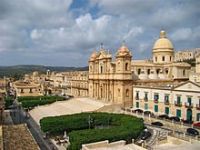Home - In and around
BACKGROUND OF NOTO SYRACUSE SICILY
Noto is the largest Sicilian municipality of 550 kmē with about 24,000 inhabitants.
Its historic center has been declared a World Heritage Site by UNESCO.
Noto is 32 km from Syracuse and is in the southwest part of the province at the foot of the Iblei mountains. Its coast, between Avola and Pachino, gives its name to the homonymous gulf.
With its 550.86 kmē, the municipality of Noto occupies over a quarter of the Province of Syracuse and is the largest municipality in Sicily and the fourth in Italy.
Background
Known ancient dates back to the Bronze Age (2200-1450 BC), it was 8 km further north on Mount Alveria, where we find the first human settlements.
It was a colony of Syracuse during the reign of Hieron II in 214 BC. about, Rome recognized her as an ally and granted the senate.
The Roman Villa of Tellaro dates back to the 4th century.
Around 550 the Byzantine legions of the Emperor Justinian conquered Noto and built the basilica of Eloro, the Trigona of Cittadella dei Maccari, the Oratorio della Falconara, the Crypt of S. Lorenzo Vecchio, the Cenobio di S. Marco, the Village of contrada Arco.
In 864 the Arabs fortified it became capillary, increased agriculture, trade and silk industry.
The Grotta del Carciofo testifies to the presence of a remarkable Jewish community.
In 1091 Noto was occupied by the Grand Count Ruggero d'Altavilla, and was subdued to his son Giordano, who began the construction of the castle and Christian churches.
During the Angevin period, on 2 April 1282, Noto participated in the insurrection of Sicilian Vespers. After the 1693 earthquake, Noto was rebuilt 8 km further downstream by several architects: Rosario Gagliardi, Paolo Labisi, Vincenzo Sinatra, Antonio Mazza, masons and stonemasons, who created a perfect baroque city.
Its historic center has been declared a World Heritage Site by UNESCO.
Noto is 32 km from Syracuse and is in the southwest part of the province at the foot of the Iblei mountains. Its coast, between Avola and Pachino, gives its name to the homonymous gulf.
With its 550.86 kmē, the municipality of Noto occupies over a quarter of the Province of Syracuse and is the largest municipality in Sicily and the fourth in Italy.
Background
Known ancient dates back to the Bronze Age (2200-1450 BC), it was 8 km further north on Mount Alveria, where we find the first human settlements.
It was a colony of Syracuse during the reign of Hieron II in 214 BC. about, Rome recognized her as an ally and granted the senate.
The Roman Villa of Tellaro dates back to the 4th century.
Around 550 the Byzantine legions of the Emperor Justinian conquered Noto and built the basilica of Eloro, the Trigona of Cittadella dei Maccari, the Oratorio della Falconara, the Crypt of S. Lorenzo Vecchio, the Cenobio di S. Marco, the Village of contrada Arco.
In 864 the Arabs fortified it became capillary, increased agriculture, trade and silk industry.
The Grotta del Carciofo testifies to the presence of a remarkable Jewish community.
In 1091 Noto was occupied by the Grand Count Ruggero d'Altavilla, and was subdued to his son Giordano, who began the construction of the castle and Christian churches.
During the Angevin period, on 2 April 1282, Noto participated in the insurrection of Sicilian Vespers. After the 1693 earthquake, Noto was rebuilt 8 km further downstream by several architects: Rosario Gagliardi, Paolo Labisi, Vincenzo Sinatra, Antonio Mazza, masons and stonemasons, who created a perfect baroque city.



